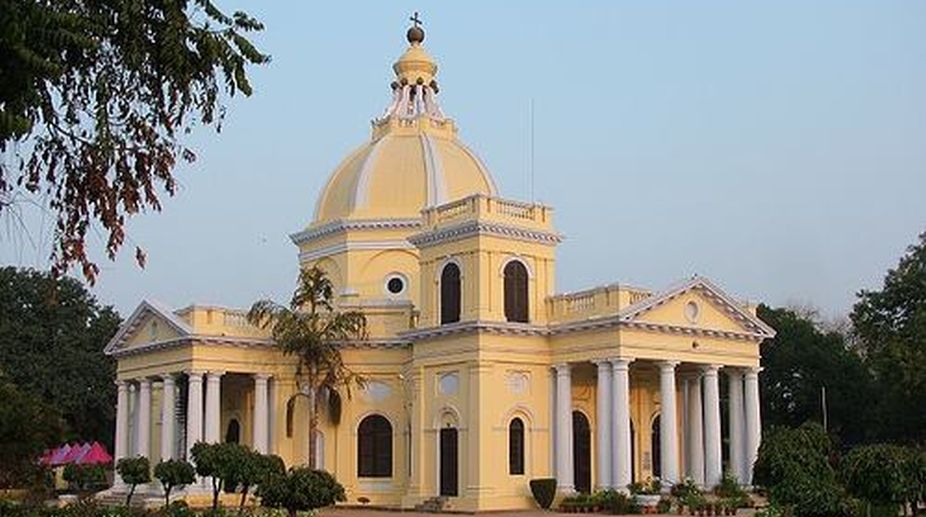Few churches in India can claim a story more romantic than that associated with St James' in Delhi- a story that goes back to the beginning of the 19th century when a soldier, left dying on the battlefield vowed to build a church if his life were spared. The soldier (Col James Skinner) not only survived to fulfill his vow, but lived to see the day when the noble monument of his piety was consecrated and named after his patron saint. That was on November 21, 1836," says an account published by the church's parish council in January, 1961.
It goes on to say that the history of the church, the oldest in Delhi, is a story of steadfast faith and courage. Son of a Scottish father and a Rajput mother, James Skinner was born in Bengal in 1778 and grew up to become a legendary figure in his lifetime. "While young James was struggling with the hardships and misfortunes of his early life ~ working as an apprentice in a printing house or looking for petty jobs in the Calcutta bazaar ~ India was passing through a period of political instability and administrative disorganisation. Delhi was witnessing the decline of Mughal glory; and in the territory surrounding the imperial city there was chaos and confusion, with Rohillas and Rajputs, Sikhs and Jats, vying with one another to claim what was left of a decadent empire. While the British Presidencies of Calcutta, Bombay and Madras were as yet isolated areas surrounded by continual turmoil, elsewhere in the country the Maratha chieftains were contending among themselves for supremacy, with one eye on the prize offered by Delhi and other on the challenge inherent in the doings of the East India Company.
"It was against this background that there emerged a number of military adventurers ~ Europeans and Eurasians ~ who set out to seek fame or fortune and were willingly employed by the warring rulers. It was such a career that James Skinner sought, and he succeeded in no small measure in achieving both renown and riches.
"The pledge to build a church took some years to fulfill ~ years that saw the second phase of James Skinner's military career. In 1803, when war broke out between the British and the Marathas, Scindia dismissed all his English and Eurasian officers. James Skinner could not resist the temptation of continuing his military career and decided to join the British forces under the command of Lord Lake. Skinner accompanied Lord Lake when he entered Delhi in triumph in 1803 after the Battle of Delhi at Patparganj.
"It was common practice at that time to recruit men for irregular forces from among prisoners of war. After the Battle of Delhi, when Lord Lake asked a group of such men whom they would have as their commander, the unanimous cry was 'Sikander Sahib' ~ that being the name by which James Skinner was known to Indian soldiers. This was the beginning of the famous force of irregular cavalry, which to this day (though now mechanised) is known as Skinner's Horse. These redoubtable cavalrymen are also known to history as the 'Yellow Boys', named after their distinctive bright yellow uniform. A scion of Skinner, Brig Michael Skinner was in command of this unit of the Indian Army till his retirement and death some years ago.
"James Skinner justified the trust of his general and the faith of his men, winning fresh laurels and achieving greater fame. He established his headquarters in Hansi, in Punjab ~ where his descendants still live at Sikandar Bagh ~ and held command of his much- honoured force till his death in December 1841, at the age of 63.
"It was in the later years of his life that his rank and seniority were regularised: James Skinner was given the rank of LieutenantColonel in the British Army and made a Companion of the order of the Bath (CB). In recognition of his meritorious services, the British administration in India gave him grants of land, and as he acquired more property he became moneyed landlord, with considerable services in Bulandshahr district (in Uttar Pradesh) and in Hansi. He also acquired a house in Kashmere Gate in Delhi, where he spent many happy days, lavishly entertaining his friends or enthusiastically discussing plans for his church, which was built in spacious park opposite his home.
"Colonel Skinner, on his death, was buried in Hansi, but a month later his body was brought to Delhi to be reinterred in the church of his creation. Moving scenes were witnessed in Delhi on the day of his funeral. St James' is the final resting-place not only of Colonel Skinner but also a number of other members of the Skinner family, some of whom died outside Delhi. Their graves and memorials are in an enclosure in the gardens facing the northern entrance to the church."
Skinner's Church, as has been stated earlier, was built in perpetuation of a vow on the battlefield of Oniara, also in Haryana, in which Skinner nearly died. It is worth mentioning the incident in his own words: "The Oonehara Rajah soon became aware of the badness of our troops and crossed the river on the 25th of January (1800)… Two of the enemy's battalions came up to attack me but I charged and drove them away." Later Skinner found that of his 300 men, only 10 were now with him. Skinner goes on to say, "As I was going to follow them (search for the other 290 men) a horseman galloped up, matchlock in hand, and shot me through the groin. It was about three in the afternoon that I fell, and I did not regain my senses till sunrise next morning… I crawled under a bush to shelter myself from the sun. Two more of my battalion crept near me ~ the one a soobahdar, that had his leg shot off below the knee, the other a jemiadar had a spear wound through his body. We are now dying of thirst, but not a soul was to be seen; and in this state we remained the whole day, praying for death. Night came on but neither death nor assistance. The moon was full and clear and about midnight it was very cold. So dreadful did this night appear that I swore, if I survived, to have nothing more to do with soldering…the wounded on all sides, including his brother crying for water ~ the jackals tearing the dead and coming nearer and nearer to see if we were ready for them, we only kept them off by throwing stones and making noises. Thus passed this long and horrible night (Hijr ki raat). Next morning we spied a man and an old woman, who came to us with a basket and a pot of water and to every wounded man she gave a piece of joaree (jowar) bread and drink from her water pot. But the soobahdar was a Rajpoot, he would receive neither bread nor water from her (as she was of a lower caste) so he preferred to die unpolluted." This was the woman whom the Colonel from then on regarded his mother…
This is a rare verbatim account, part of the Colonel's memories written in Persian, which to one's knowledge has never been published in any newspaper to-date and shows the plight of the man when he vowed to build a church as a token of his gratitude. To do that he had to live close to the site he had chosen and hence the importance of the Kashmere Gate house him. He would walk across from it to the under construction church (opened in 1840) before returning for a cherished meeting with his friend, the British Resident William Fraser. Shouldn't this building, spread over more than 500 sq yards be restored and preserved by the Archaeological Department as a heritage site?










